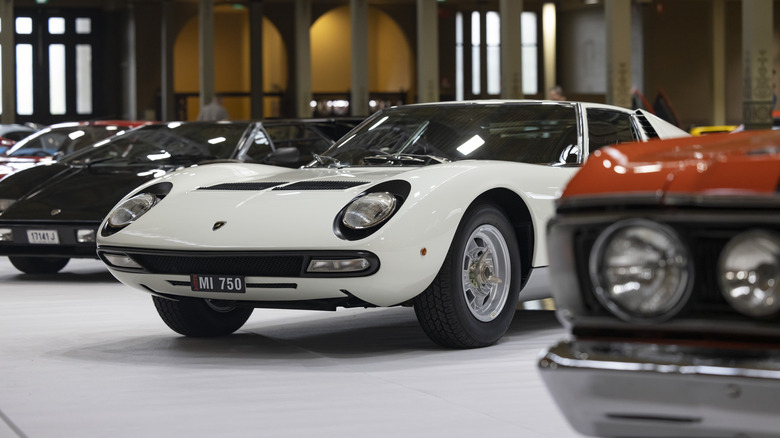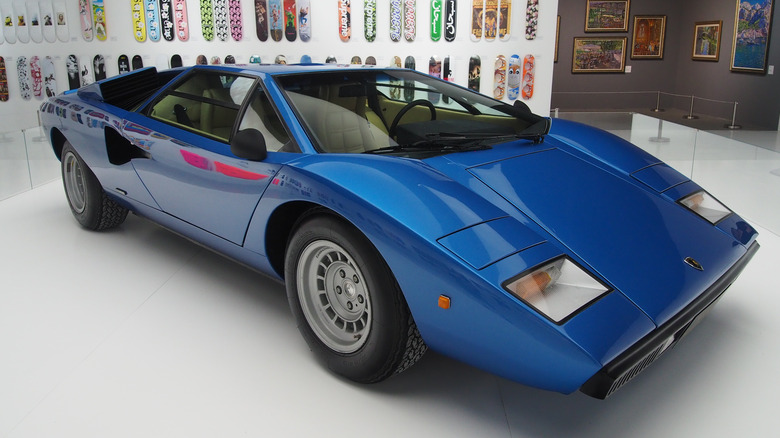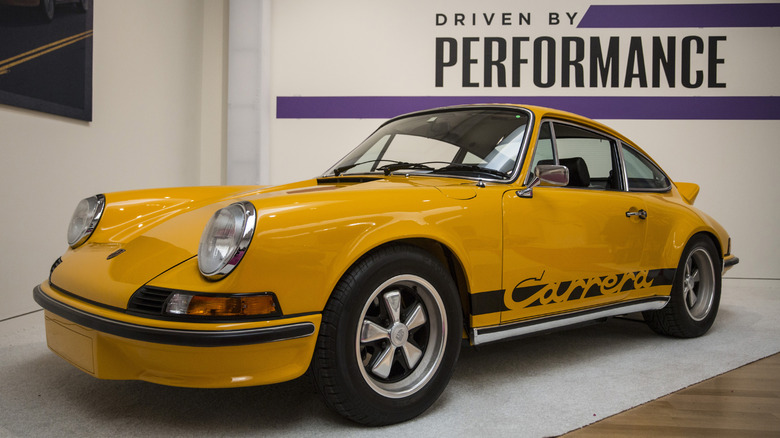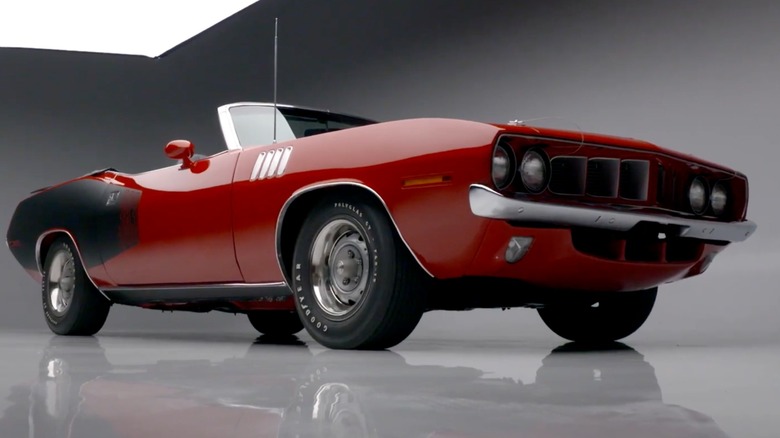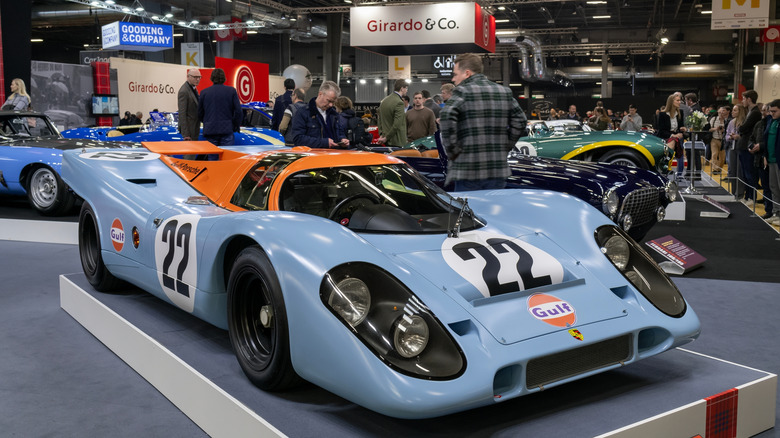These '70s Cars Are Worth A Ton Of Money Today
What a decade the 1970s were! To start with, Black Sabbath defined heavy metal, although some still complain about that. It was the best of times for bands such as Rainbow, Kiss, Judas Priest, and AC/DC that were roaring across stages worldwide. And don't forget the release of "Hotel California" from the Eagles, the somewhat ugly wallpaper, and wild trousers. The 1970s also marked the genesis of modern technology, with Microsoft and Apple laying their foundations to transform everything from business to entertainment, and the rise of blockbuster cinema — something unknown in the 1960s — with "Jaws," "Star Wars," "Rocky," "Alien," and "Saturday Night Fever," among many more. And, of course, this period saw some of the most exciting cars ever built — Hemis with NASCAR wings, Italian wedges resembling stealth fighters, and Porsches with ducktail spoilers, all now fetching unbelievable amounts of money.
Their price tags are not just because of their rarity or horsepower, but because they've become myths, with collectors happily paying to own a slice of that mythology. Back then, across Europe, Japan, and the United States, carmakers were quietly (and sometimes loudly) creating machines that would go on to define entire generations of enthusiasts. Some of them were sculpted by visionary designers, and others were simply brute-force monsters, while a few ended up immortalized on film or in motorsport history. So let's look under the hood, step into the cockpit, and take a road trip through 10 iconic 1970s cars worth a ton of money today, literally, proving that six- and seven-figure hammer prices are no longer unicorns.
1973-78 Lancia Stratos HF Stradale — $636,000
With a low angle, a rally driver's helmet for a windshield, and a go-kart-like wheelbase, the Stratos rises as if coming from a cartoon. But it isn't. It's a real legend. Under its rear clamshell sits a Ferrari Dino 2.4-liter V6, good for roughly 190 horsepower, bolted to a five-speed and enclosed in a steel structure with a fiberglass body. Weight? About 980 kilograms. The payoff is a barely legal road homologation special, which crackles with racing spirit. Alive, the steering wheel pulsates in your hands, the intake roars close to your ears, and the chassis darts for apexes. Too poetic indeed. On the inside, it's a Spartan cockpit with simple instruments, no frills, and visibility that prioritizes pace notes over parallel parking. Fit and finish, Italian, obviously, which is part of the charm. In the 1970s, the Stratos was untouchable on gravel and tarmac, delivering World Rally Championships in 1974, 1975, and 1976.
If you're wondering how much you'd have to pay for this model, in 2024 RM Sotheby's sold a Lancia Stratos HF Stradale for about $636,000 in Monaco. Clean examples can be found in the mid-six-figure band, but immaculate specimens may push even higher. This isn't one of the car brands that cost the least to own over time. But why the money? First, limited production (only around 492 were produced). Second, rally pedigree. Third, driving experience. And finally, the magic wedge-shaped touch of legendary Italian designer Marcello Gandini, also known for creating iconic cars such as the Lamborghini Miura and Countach (both on this list), Fiat X1/9, BMW 5 Series first generation, and Maserati Shamal, among many more. The Lancia Stratos HF Stradale is the point where strange beauty, power, and rarity intersect. Followed by checkbooks.
1974-76 Lamborghini Countach LP400 Periscopio — $979,000
The Lambo Miura is romance. The first-series Countach is shock and awe — a low, razor-edged wedge with scissor doors and a roof-periscope slot that gave it the nickname "Periscopio." Another unforgettable design from the mind of the illustrious Marcelo Gandini. Its 3.9-liter V12 is a rear mid-engine mounted longitudinally (instead of transversely) that you'll find just behind the driver's seat, and the gearbox is positioned in front of the engine to help centralize mass for improved handling at high speeds. Such an installed power delivers a top speed of 195 mph and 0-60 mph in the 5.4-second range. When you open the doors, or rather, lift the doors, you uncover a surprisingly artisanal raw cockpit, even a little imperfect.
No high-tech or lavish space. Crafted with care, yes, but designed for speed. Just mechanical gauges with needles and numbers, depicting the purity and simplicity of 1970s supercar instrumentation. To pilot it, you step over slim doorsills to reach the driver's seat. No graceful slide here. It's an awkward maneuver to climb inside. What's a Lamborghini Countach LP400 "Periscopio" worth today? At the 2018 Pebble Beach auction, Gooding & Company moved a 1976 example for $979,000, while RM Sotheby's has another '76 listed in Miami with a $1.1 million to $1.4 million estimate. Not yet sold, but with only 150 units ever built, it's waiting for the right bidder.
1972-74 Ferrari Dino 246 GTS — $1 million
The joke used to be, "A Dino isn't a real Ferrari." Oh, really? Well, for the cynics, the 246 GTS is now a blue-chip poster car coming from the 1970s. Ferrari's own data put its debut at the 1972 Geneva show with irresistible hardware. It boasted a 2.4-liter 65-degree V6 with triple Webers, 195 horsepower, and a five-speed transaxle. Sheer power. Inside, you sink into snug bucket seats, face a soft "mouse-hair" dashboard, and flick an open-gate shifter that clicks like a tiny instrument. Even the Italian switches feel stylish and just a touch dramatic. Road performance lands in the mid-6-second 0-60 sweet spot and a top speed around 140 mph, but the true magic is how it reacts: full-of-life steering, the engine eager, and the whole car seeming to wrap itself around you.
On the money front, Gooding & Company sold a 1974 GTS for $1,028,000 at Pebble Beach 2025, the first time a Dino officially cleared the million-dollar line at that sale. Not a "real" Ferrari, huh? Tell that to the auctioneer. But there are quite a few Dinos changing hands for well into the six figures, filling out the rest of the market. Gooding moved another specimen in 2024 for $555,000, while Bring a Trailer recently hammered a long-held 1973 example for $600,000. Most of the Dino's appeal lies in the fact that you can drive it on the streets. A little outlandish, but in the right color, you'd get something that feels dynamic at 35 mph and still looks like a million bucks.
1970 Plymouth Superbird 426 Hemi — $1.65 million
Would you mind driving a car with a wind-tunnel-shaped nose cone and a rear wing down an L.A. freeway? If the answer's no, you'd be piloting the 1970 Plymouth Superbird. This monster is pure NASCAR science in sheet metal, just like its cousin, the 1969 Dodge Charger Daytona HEMI, one of those classic cars now worth a small fortune. As reported by Barrett-Jackson, a Hemi Superbird set a $1.65 million auction record at the 2022 Las Vegas sale. Without a doubt, extreme homologation eccentricity can fetch top dollar. This is not the type of car upper-class people buy to save money but to grow their wealth. According to spec sheets, Hemi-powered cars, including the Superbird, could rip from 0 to 60 mph in the five-second range, while the aero kit only really came into its own once you pushed past 60 — when the wing starts to work as God commands.
Now, power. Under the long nose lives the mighty 426 Hemi, a 7.0-liter V8, which delivers a factory-rated 425 horsepower at 5,000 rpm and a thumping 490 pound-feet of torque at 4,000. To feed the big block's appetite for fuel, dual four-barrel carburetors were installed without hesitation. Remember that the Hemi was an engine built for NASCAR first — to sail past 200 mph and outclass other car brands — and for public roads only second, which explains its ferocious components. When you open the door and look inside, you'll find Mopar muscle everywhere, from bench-to-bucket sturdiness to vinyl that wears its age well, and the sense that you're gripping something designed to be hammered at Talladega, never coddled.
1971-73 Ferrari 365 GTS/4 Daytona Spider — $2.2 million
There's nothing discreet about it. Certainly not the price. At Monterey 2024, RM Sotheby's sold a 1972 Daytona Spider for $2.2 million, a sale that showed how far modern cars still are from achieving the timeless aura of a 1970s Ferrari. With a big engine and a long hood, the Daytona Spider is the open-air GT that can make your neighbors jolt. A Ferrari 4.4-liter 251 Colombo V12 lives inside this cute (yes, cute, because it's adorable) monster, which delivers something like 352 horsepower, breathing through six Weber carbs and paired with a five-speed transaxle to keep weight centered. Driving one is exactly the theater you want. Factory figures quote a top speed nearing 174 mph (280 km/h), fast enough to help you arrive on time when heading down an empty interstate.
Inside, it's classic Modena grand touring, featuring low-set leather buckets, a firm, thin-rimmed helm, a lattice of Veglia gauges, and a roof you fold away because that V12 deserves an audience. And a wide audience it got. Remember "Miami Vice" from TV? James "Sonny" Crockett drove a 1972 Ferrari Daytona Spider with the Florida number plate ZAQ178 in the first two seasons of the series. In season three, it was destroyed on screen in the episode "When Irish Eyes Are Crying" when a Stinger missile hit it. You can breathe now. The car wasn't original; the show used replicas built on Chevrolet Corvette (C3) chassis to look like the real thing. What a relief. Authentic Daytona Spiders were, and still are, extremely expensive and rare — only 122 units were made. Hence the high price.
1973 Porsche 911 Carrera RS 2.7 — $2.42 million
The RS 2.7 is the 911 distilled — lighter, sharper, faster — and that ducktail didn't just look cool; it worked at high speeds. From the moment you sit down, it's clear that Porsche made this car for drivers, not passengers. It tops out at 149 mph (240 km/h) and hits 0-60 mph in about 5.6 seconds in the Touring version. The Lightweight, with thinner body panels and less sound insulation, goes a little quicker, reaching 152 mph (245 km/h). Power came from a 2.7-liter flat-six engine rated at 210 horsepower, and its Lightweight trim felt like a homologation special because that's what it was. According to Porsche Classic's spec history, the RS 2.7 is the gold standard on how to turn a sports car into a scalpel, and the market agrees. Gooding & Company hammered a 1973 RS 2.7 Lightweight for $2.42 million at its Pebble Beach auction in 2022, with the lot listing stating it was "among the finest of the 200 Carrera RS Lightweights built."
As Gooding noted, the seven-figure fixture is due to a blend of motorsport credibility, instant recognizability, and driving experience. The RS 2.7 is considered one of the most collectible versions of the 911 because of limited production and intense demand. In appreciation terms, no doubt a pristine specimen could reach higher prices. If you want to buy one as a long-term investment, consider the version (Lightweight over Touring), provenance, and condition. For instance, in February 2025, RM Sotheby's sold a Touring for $720k, while the same house hammered a Lightweight in December 2023 for $1.8 million in Houston. Keep in mind that everything depends on the market, since time doesn't necessarily mean rising valuation.
1970 Toyota 2000GT — $2.5 million
The 2000GT is mic-drop proof that Japan could go toe-to-toe with the finest from Europe and America. Beneath such an impossibly low bonnet sits Toyota's jewel-like 2.0-liter 3M DOHC straight-six engine fed by triple Mikunis and twin cams and backed by a five-speed gearbox with a limited-slip differential. Such a combination offers a top speed that nears 135 mph. Slide inside to enjoy rosewood veneer and a three-spoke wood steering wheel crafted by Yamaha's instrument division — less gadgetry, more craftsmanship — the sort of embellishment that sends collectors weak at the knees. The Toyota 2000GT wasn't just a pretty face; it proved its value when racing legend Carroll Shelby entered two in the SCCA (Sports Car Club of America) in the late 1960s. That connection gave the model serious credibility.
When launched in the 1960s, a 2000GT was worth about $7,230 (about $52,792 in today's money). Fast forward to March 2022: Gooding & Company sold one of those Shelby-prepared 2000GTs at Amelia Island for $2.53 million, a world record for any Japanese car at auction. Evidently, it's among the Toyota models with the strongest resale value. In the collector realm, history and provenance mean everything. Now, cinematic royalty. The 2000GT became immortal when it was featured in the 1967 James Bond film "You Only Live Twice," starring Sean Connery as 007. Toyota built two convertible (open-top) versions exclusively for the film because Connery was too tall to fit comfortably inside the standard coupé. Those were the only open-top 2000GTs ever made. Although the car appeared in only a few scenes throughout Tokyo and rural Japan, those sequences transformed Toyota's image from a maker of dependable family vehicles into a brand capable of producing first-rate sport machines.
1971 Plymouth Hemi 'Cuda Convertible — $3.5 million
So, you want American money muscle? This is the poster child. The 1971 Hemi Cuda ragtop blended Chrysler's almighty 426 Hemi with the E-body's menace (shared with the Dodge Challenger) and just enough luxury seen in its high-back buckets, Rallye gauges, and a pistol-grip shifter feel even if your car was an automatic. Mopar historians note only 11 were built in 1971, which explains why collectors would kill to get one and treat each survivor like fine art. As reported by Mecum, in June 2014, a '71 Hemi Cuda Convertible sold at its inaugural Seattle auction for $3.5 million, an almost unthinkable figure that resets everything everybody knew about muscle- and pony-car values. The appeal is understandable.
Under its long, aggressive hood lurks a 426-cubic-inch, 7.0-liter Hemi V8 officially rated at 425 horsepower and 490 pound-feet of torque. This monstrous engine teamed up with a four-speed manual transmission (in the most desirable examples) and drove the rear wheels, which brought race-car performance to the streets. To match the fire-breather up front, Plymouth built a proper chassis and running gear: heavy-duty suspension, wide tires, and a rear-axle package that could handle the thrust. Regarding speed, the coupe version topped out at around 134 mph (215 km/h) and had a sprint from 0 to 60 in about 5.3 seconds. If you're hunting one and are willing to pay any price, well, you'd be shopping at the top end of the market and ready to spend serious money.
1971-73 Lamborghini Miura SV — $4.9 million
The supreme factory tune of the Miura, the SV (Super Veloce in Italian), is often credited with inventing the modern supercar layout. It became the template for every mid-engined V12 Ferrari and Lambo that followed. Celebrated designer Marcello Gandini conceived it in his mid-20s while working for Carrozzeria Bertone in the late 1960s. He shaped the entire Miura line (P400, S, and SV) with impossibly low proportions, dramatic curves, and the now-iconic "eyelash" headlamp seen on early cars. The SV brought a sideways-mounted 3.9-liter V12 engine making around 385 horsepower and a factory-claimed top speed close to 180 mph (290 km/h). As per Lamborghini's own history notes, the SV's carburetor and lubrication updates delivered the sharpest, most muscular Miura, while the interior could be customized to taste with fine Italian leather and gauge binnacles.
The money? With only 150 units built, it is priced really high. Stratospherically, if you will. In Toronto, Canada, at RM Sotheby's Dare to Dream 2024 sale, a 1972 Miura P400 SV sold for an astronomical $4.9 million — a record according to multiple market trackers. Financial experts have often recommended that you should buy only used cars to save thousands of dollars. Well, it's clear they haven't been to a 1970s mid-engine supercar auction. Cinematically speaking, an unforgettable orange Miura glides through the Alps in the film "The Italian Job" (1969) before meeting its fate in a tunnel with the mafia. Though brief, that scene immortalized the Miura as a symbol of Italian speed and style, which is evident today in its extraordinary value.
1970-71 Porsche 917K — $14 million
Some cars are expensive. Others are extremely valuable. And above them all sits the Porsche 917K, a myth with a chassis number and the most celebrated member of the legendary 917 line. The "K" stands for Kurzheck, German for "short tail," the body that famously won Le Mans in 1970 and 1971. The Porsche 917K earned immortality in Steve McQueen's "Le Mans" (1971), the ultimate racing film of that era, where McQueen's Gulf-blue bodywork and howling engine became icons. The movie used genuine race cars, authentic drivers, and original footage shot during the actual 1970 24 Hours of Le Mans, meaning the 917Ks on the screen are the real deal. At auctions, the figures are bonkers. In 2017, Gooding & Company's Pebble Beach sale set a then-Porsche record when an ex-film specimen hammered for a reality-bending $14,080,000. Fancy a defibrillator?
In 2025, another 917K directly associated with McQueen went to Mecum's 2025 Kissimmee sale, but despite jaw-unhinging bids reported in the mid-eight digits, it didn't sell. Perhaps it would've surpassed the previous million barrier. This is the type of collectible that can boost your net worth, since only 36 units were produced. The 917K's heart is a 4.5- to 5.0-liter air-cooled flat-12 engine, which delivered up to 600 horsepower. Top speed typically hits around 220 mph (350 km/h) depending on the aero package and configuration. In the cockpit, you'll see a pure race-car zone, no frills — a tubular space-frame chassis, an aircraft-thin wheel, a single central instrument cluster, seat and harness, exposed metalwork, and little else. Remember, this car was designed for endurance racing, not comfort.
